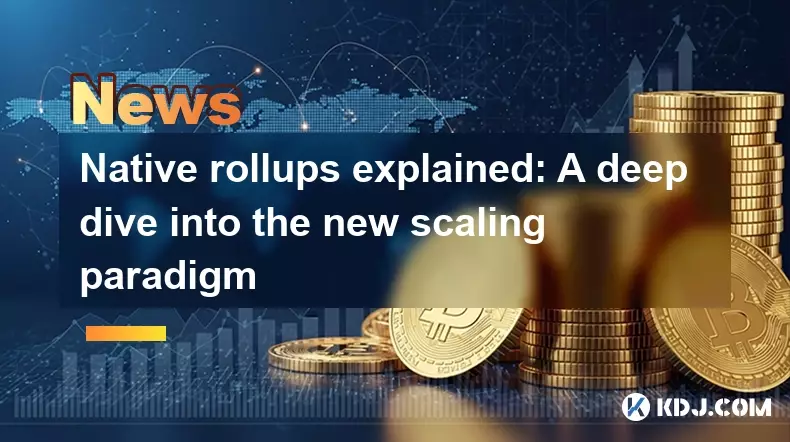 |
|
 |
|
 |
|
 |
|
 |
|
 |
|
 |
|
 |
|
 |
|
 |
|
 |
|
 |
|
 |
|
 |
|
 |
|
Cryptocurrency News Articles
Native rollups explained: A deep dive into the new scaling paradigm
Mar 21, 2025 at 10:30 pm
All of a sudden, it seems that everybody in the Ethereum ecosystem is talking about native rollups

All of a sudden, it seems that everybody in the Ethereum ecosystem is talking about native rollups, with Ethereum Foundation researcher Justin Drake saying that everyone he’s spoken to about the proposal has been immediately supportive.
Optimism, Base, and half a dozen other L2s have expressed a desire to incorporate the tech into their platforms — and some also want to become “based rollups” for good measure.
But with Drake’s January post on EthResearch aimed at a technical audience and most other explainers using the arcane terminology of blockchain devs, many ordinary Ethereum supporters may be left with little idea what native rollups are or how they work.
So, we’ve roped in experts from the 2077 Collective and the Ethereum Foundation to help explain it in plain English.
What is a native rollup?
The TLDR is that native rollups make L2s as secure and trustless as Ethereum itself by getting the base layer to take care of all the stuff that currently requires a complicated and difficult Zero Knowledge (ZK), or fraud, proof system on every L2.
From a user’s perspective, you could feel as safe and secure keeping your $10 million in life savings on a native rollup as you would storing it on Ethereum itself.
“Native rollups seem like a no-brainer for rollups. They are so much simpler and much more secure,” explains Ethereum Foundation researcher Ladislaus.
“They can inherit L1 security with just a few lines of code by calling the precompile in the future.”
“Precompile” refers to a special type of contract hardcoded into the Ethereum protocol that extends the Ethereum Virtual Machine’s (EVM’s) capabilities. Drake’s proposal is for “an elegant and powerful execute precompile” that turns the native rollups into “programmable execution shards.”
So you can think of it as sort of a reboot of the old Eth 2.0 sharding plan.
How do native rollups work?
Basically, they’re an overhaul of the way proofs work on L2s. These are little cryptographical snapshots that record the state of who owns what on the rollups that are periodically written to Ethereum. By recording the state of L2s on the Ethereum blockchain, rollups benefit from Ethereum’s massive decentralized network, and users are able to permissionlessly withdraw their funds from rollups if required and force through transactions censored by the sequencer.
At present, Ethereum Virtual Machine-compatible optimistic rollups essentially just assume everything that happened was correct (hence the name) and write that to Ethereum. Then there’s a seven-day period during which a few select actors can challenge anything dodgy with a “fraud proof” before assets can be withdrawn to Ethereum.
EVM-compatible ZK-rollups like Linea, however, use cryptographic proofs that show beyond a shadow of a doubt that the relevant computation was performed on the rollup, which allows for much faster withdrawals to the L1.
Also read: Pectra hard fork explained — Will it get Ethereum back on track?
The native rollup proposal would mean the L2s would not need to establish the same sorts of elaborate proof systems and security councils as they do now. Instead, they provide the Ethereum base layer with a list of transactions called a “trace.”
The execute precompile then uses Ethereum’s execution engine to re-execute the computation and verify the state transitions, which is just a fancy way of saying that it makes sure that whatever just happened on the rollup was correct.
Later versions will see ZK-proofs incorporated, which is when native rollups will shine.
What are the benefits of native rollups?
The major benefits are that the rollups won’t need to build difficult and complex proof systems or rely on security councils or multisigs, allowing a small trusted group to step in when things go wrong or if the proofs are buggy.
“Native rollups don’t risk being drained due to a problem with the proof system and can safely get rid of security councils, improving their decentralization,” says Alex Hook, a researcher at 2077 and Untronfi CEO.
And for users, Hook says, “Their funds on a native rollup are as secure as Ethereum with no trust assumptions added.”
The problems with native rollups
For the L1, Hook says, native rollups bring “fully secure and decentralized scaling at the cost of significantly increased protocol complexity.”
Another issue is that using Ethereum nodes to re-execute the transactions to verify they’re all kosher would be very slow and seems to contradict the whole point of rollups, which is to move execution off of the achingly slow Ethereum base layer.
While the execute precompile is designed to be slightly more efficient than full re-execution, Drake says the first version should just be seen as a “stepping stone” along the road.
L
Disclaimer:info@kdj.com
The information provided is not trading advice. kdj.com does not assume any responsibility for any investments made based on the information provided in this article. Cryptocurrencies are highly volatile and it is highly recommended that you invest with caution after thorough research!
If you believe that the content used on this website infringes your copyright, please contact us immediately (info@kdj.com) and we will delete it promptly.





























































